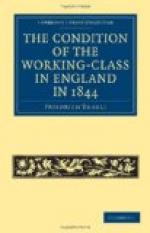If we leave the Irk and penetrate once more on the opposite side from Long Millgate into the midst of the working-men’s dwellings, we shall come into a somewhat newer quarter, which stretches from St. Michael’s Church to Withy Grove and Shude Hill. Here there is somewhat better order. In place of the chaos of buildings, we find at least long straight lanes and alleys or courts, built according to a plan and usually square. But if, in the former case, every house was built according to caprice, here each lane and court is so built, without reference to the situation of the adjoining ones. The lanes run now in this direction, now in that, while every two minutes the wanderer gets into a blind alley, or, on turning a corner, finds himself back where he started from; certainly no one who has not lived a considerable time in this labyrinth can find his way through it.
If I may use the word at all in speaking of this district, the ventilation of these streets and courts is, in consequence of this confusion, quite as imperfect as in the Irk region; and if this quarter may, nevertheless, be said to have some advantage over that of the Irk, the houses being newer and the streets occasionally having gutters, nearly every house has, on the other hand, a cellar dwelling, which is rarely found in the Irk district, by reason of the greater age and more careless construction of the houses. As for the rest, the filth, debris, and offal heaps, and the pools in the streets are common to both quarters, and in the district now under discussion, another feature most injurious to the cleanliness of the inhabitants, is the multitude of pigs walking about in all the alleys, rooting into the offal heaps, or kept imprisoned in small pens. Here, as in most of the working-men’s quarters of Manchester, the pork-raisers rent the courts and build pig-pens in them. In almost every court one or even several such pens may be found, into which the inhabitants of the court throw all refuse and offal, whence the swine grow fat; and the atmosphere, confined on all four sides, is utterly corrupted by putrefying animal and vegetable substances. Through this quarter, a broad and measurably decent street has been cut, Millers Street, and the background has been pretty successfully concealed. But if any one should be led by curiosity to pass through one of the numerous passages which lead into the courts, he will find this piggery repeated at every twenty paces.
Such is the Old Town of Manchester, and on re-reading my description, I am forced to admit that instead of being exaggerated, it is far from black enough to convey a true impression of the filth, ruin, and uninhabitableness, the defiance of all considerations of cleanliness, ventilation, and health which characterise the construction of this single district, containing at least twenty to thirty thousand inhabitants. And such a district exists in the heart of the second city of England, the first manufacturing city of the




